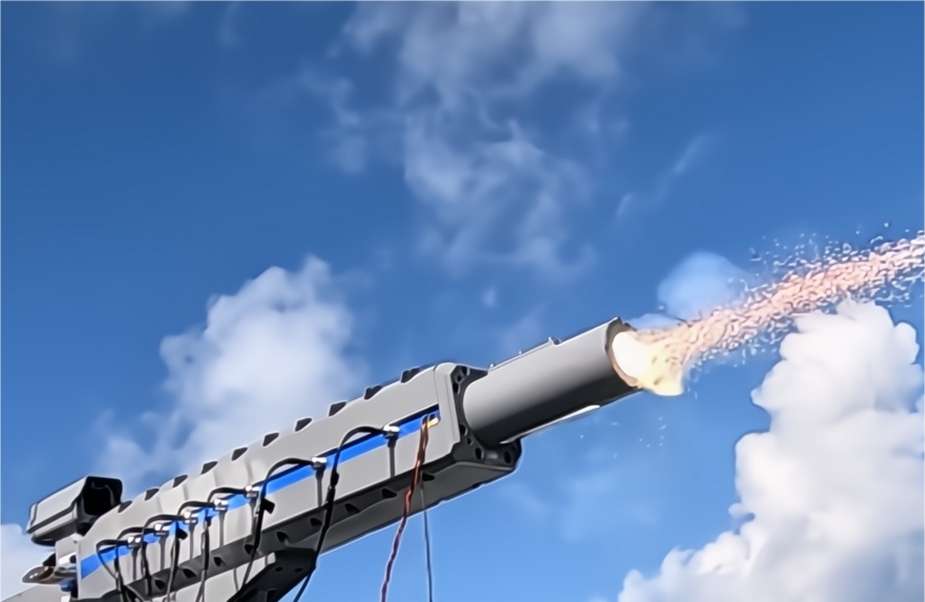Breaking news
Japan makes maritime history with first successful sea-based electromagnetic railgun test.
As reported on October 17, 2023, by the Acquisition Technology & Logistics Agency (ATLA), a part of the Japanese Ministry of Defense, Japan's Maritime Self-Defense Force (JMSDF) achieved a significant milestone with the successful sea-based test firing of its medium-caliber maritime electromagnetic railgun. Collaborating with ATLA, this marks the first documented sea-based railgun successful test.
Follow Navy Recognition on Google News at this link
 Japan's Maritime Self-Defense Force (JMSDF) achieved the first documented sea-based railgun successful test (Picture source: ALTA)
Japan's Maritime Self-Defense Force (JMSDF) achieved the first documented sea-based railgun successful test (Picture source: ALTA)
Specific details about the test, such as the exact date and the vessel used, remain undisclosed. Video footage released by ATLA provides a glimpse of the test. The railgun was demonstrated firing projectiles from various angles, showcasing its readiness for operational use.
ATLA's medium-sized electromagnetic railgun prototype, unveiled in May 2023, fires 40mm steel projectiles weighing 320g using an electromagnetic propulsion system. It can accelerate projectiles to hypersonic velocities, reaching approximately 2,230 m/s (Mach 6.5). The weapon currently utilizes five megajoules (MJ) of charge energy, with a planned upgrade to 20 MJ for enhanced performance.
Even at this mid-caliber size, the electromagnetic railgun's capabilities make it a valuable asset for countering a range of aerial threats at sea, including hypersonic cruise and potentially hypersonic ballistic missiles. Furthermore, ATLA has expressed intentions to employ land-based railgun systems to target hypersonic missiles.
Deployment platforms for these railguns remain unconfirmed. However, past indications suggest that Japan may potentially mount them on some of its Maritime Self-Defense Force destroyers, given the improved power-generating capabilities of these vessels. Furthermore, Japan's in-development multi-purpose missile defense vessels may serve as potential hosts for this technology.
The road to achieving an operational naval railgun system presents numerous challenges. Railguns are known to encounter issues related to corrosive saltwater, constant shocks, extreme heat, and cold, all of which are ever-present factors in the maritime environment. Despite the progress made, significant hurdles remain to realize a fully operational naval railgun system.
Japan's pursuit of railgun technology is a response to global threats in the Indo-Pacific region. North Korea's expanding missile capabilities, including hypersonic weapons, pose a significant danger to Japan. The country has faced missile threats from North Korea, and the government has pledged to intercept and neutralize any North Korean missiles entering its airspace.
Furthermore, Japan faces challenges in the East China Sea, with territorial claims over islets such as the Senkaku Islands. This contested region presents a potential hotspot for conflict, with China's rapidly evolving anti-ship missile arsenal posing a considerable threat, such as the DF-100 cruise missile.
Japan's commitment to the development of electromagnetic railgun technology is noteworthy, especially in the context of the U.S. military abandoning its own railgun development programs in 2022. However, there remains the possibility of collaboration between ATLA and U.S. contractors, potentially enabling the United States to indirectly re-enter railgun technology development.
In addition to Japan, other nations are actively advancing railgun technology. On July 19, 2023, the French Defence Procurement Agency unveiled a new electromagnetic cannon project for naval ships, developed by the Franco-German Research Institute of Saint-Louis (ISL) and funded by the Defense Innovation Agency (AID).
China, for instance, has made significant strides in the field, having developed a large-caliber railgun prototype. On August 30, 2023, China's Navy reportedly successfully tested its railgun, noted for its ability to fire a 124-kg (273-lb) projectile at speeds of 700 km/h (435 mph) in less than 0.05 seconds.
On September 28, 2023, the European Defence Agency (EDA) hosted the final meeting of the PILUM project, which focuses on a disruptive concept for an electromagnetic railgun (EMRG) – a future complementary artillery system with the potential for significantly higher projectile velocities and longer-range impact.























